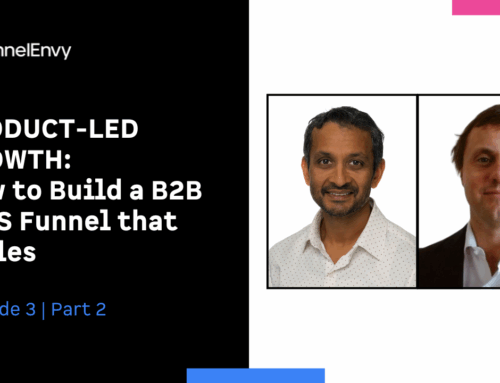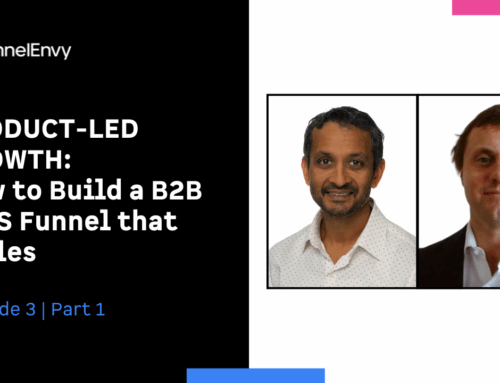Transcript:
Hi, everyone. I’m Arun from FunnelEnvy. Today I want to spend some time talking about how we solve the revenue funnel data challenge.
Of course, many of you are running multiple campaigns on lots of different channels. You have digital advertising, paid acquisition campaigns that are heavily optimized, and you spent a lot of time getting people into your marketing automation platform and running really personalized email nurture campaigns to them.
Now, of course, the main problem that we focus on at FunnelEnvy is that the main thing in the middle that glues a lot of that customer journey together is your website. Of course, for many of us, it’s a static experience. Unlike the other channels, prospects and customers keep coming back to that same static website. In many cases, it’s just not keeping up and dragging down your conversion rates and ultimately your pipeline that you’re delivering to the sales team.
Now, that’s a broad example of some very specific demand gen website problems that we commonly run into. You’re probably looking at website analytics, and if you’ve spent any time in there, it’s not easy to tell which experiences and offers, things like landing pages or other offers, content, are actually contributing to revenue. Maybe you’re running experiments and campaigns on your website, and it’s also hard to measure the pipeline and revenue impact from those website experiments. Of course, a static website that’s showing the same thing to every buyer at every stage isn’t very effective at moving prospects efficiently through the funnel.
Now, of course, the demand gen revenue journey is long and complex. This is just one example of someone coming to the site, downloading content, getting on an email sequence, attending a webinar, talking to sales who finally opens it up and later on closes the deal. The important thing to understand is that, of course, that revenue journey occurs in multiple different contexts, multiple different channels, and ultimately different platforms in our backend martech stack, from the website and the website analytics to the marketing automation platform and ultimately the sales team and the CRM platform.
Now, the net effect of this is we end up creating a lot of data silos in our stack. Website analytics, the CMS or the optimization tools, maybe third-party firmographic data providers, our backend systems like marketing automation and CRM, these are all silos of information that all have individual pieces of that entire customer journey. We can think of those individual pieces as pieces of the puzzle that, if we put together, can actually present a cohesive picture of those individuals and accounts and their opportunities as they move throughout that customer journey.
Now, the important thing is having that glue that can bring all of those puzzle pieces together and not only receive data from those individual systems, but also feed them and also feed our business intelligence or reporting. For now, we’re going to call that a customer data platform, or CDP. This is similar to a data warehouse, but it has some very specific features that we want to see to be able to solve some of those problems that we were talking about.
First off, it’s not just sufficient for this CDP to receive data. It needs to have bi-directional integration to a lot of these solutions so it can pass data between these different platforms. Certainly, it unifies all of these puzzle pieces, or that profile data, and because we’re talking about demand gen, it happens both at an individual and an account level. It has that full view of the customer journey, so unlike website analytics that’s only looking at what’s happening on site, it has that perspective tied to that unified customer profile of what happens not only on the website, but also down the funnel as that leads to account progress towards revenue. It allows for rich segmentation because we have those unified customer profiles and full perspective on that buyer journey, and because we’re talking about website optimization, allows for real-time resolution to be able to target those different audiences on the website.
Let’s get into some of the specific use cases of the customer data platform. First off, we can use it to enhance our existing web analytics. If you spend a lot of time looking at your website performance and in platforms like Google Analytics you know that you’re typically only looking at those vanity metrics, things like bounce rates and visits and exit rates. Unfortunately, a lot of the interesting data that we have lives in our marketing automation, our CRM, the leads, contacts, accounts, and opportunities that we’re really seeking to improve and understand.
By pumping this data into our CDP and unifying it and then feeding those down-funnel outcomes into our web analytics, as well as our reporting and dashboards, we get a much more complete picture of that revenue journey for that visitor. This lets us answer questions like which experiences and offers on my site are actually contributing to revenue, and how much? You see here a landing page report, but instead of only looking at your typical vanity metrics you see on the right, we actually can visualize the closed one revenue of each of those landing pages. Of course, you can take any of those dimensions that you’re typically looking at in a web analytics and understand the pipeline and revenue impact this way.
You can also answer ad hoc questions through dashboards, like my website traffic, not just in terms of numbers, but by different buyer stages and the expected revenue of each. This often starts the hypothesis process of how can I actually target those different buyer stages differently to accelerate them through that revenue funnel.
Once you actually get into running experiments and campaigns, it can be very difficult to understand how much pipeline and revenue those experiments and campaigns are actually generating, especially if you’re using a multi-touch attribution model, which many of you are. We can solve that problem by bringing, again, that lead, contact, account, and opportunity data, as well as the touchpoints in my attribution model and the test and campaigns from the optimization platform, and feeding those into my reporting and business intelligence environment.
By doing that, we can start looking at the amount of sourced pipeline using that attribution model that my website campaigns and experiments have delivered over time. We can start comparing campaigns, not just on their ability to get people to fill out a form, but based on the actual pipeline and revenue impact that they’ve had. We can look at individual campaigns and the variations in those campaigns and understand which variation is most effective, again, not just in terms of those onsite vanity metrics, but their ability to deliver results down the funnel.
Finally, when we’re talking about optimizing the revenue funnel, a lot of it is about targeting in real time and targeting the right offers to different personas, different groups of accounts, and my personal favorite, by buyer stage, to move prospects more efficiently through the funnel. Now, to do this, again, we’re bringing over that same marketing automation and CRM data, but potentially also that website behavior from web analytics, and in this case, feeding that into audiences in our content management system or our testing and optimization platform. In this case, this isn’t a reporting use case, so that audience has to be delivered in real time based on an individual visitor as they come into the site. If you can do that though, we can start doing things like personalizing those offers based on that buyer stage and where they are in the journey, or even differentiating offers and changing the experience in real time to present the best offer based on the persona that’s coming to the site.
With that, I want to leave you with some takeaways. If you’re a demand gen marketer and you’re looking at your website performance and even optimization of it, our recommendation is always not to settle for top-of-the-funnel KPIs. Those vanity metrics, those engagement metrics, even form conversions, they’re not sufficient. Really, you should be trying to align your efforts with the way the rest of the team and organization measure success. For a demand gen team, that’s based on pipeline and revenue impact.
Of course, demand gen sites, demand gen marketers, typically deal with long customer journeys. What that often means for your site is that you have a lot of return visitors. They’re coming back to the site at different stages in the buying journey with differentiated intent, but the measurement of pipeline and revenue and the ability to understand those different buyer stages and ultimately target them is really related to how efficiently you can bring that data together and activate it in real time.
Then finally, many of you may have already invested in a data lake or data warehouse to unify that data that you have in these different silos together. Typically, this is done for attribution use cases and other reporting and measurement use cases. It’s a great starting point. Our CDP often compliments existing data lakes or data warehouses, but the reason that we have to compliment it is that typically those are solutions that aren’t built for that real-time use case. If you get into the targeting and activation of that data in the milliseconds that are required by the time a visitor comes to the site and you deliver them that web experience, it requires a real-time source, in our case, the FunnelEnvy customer data platform.
With that, I want to thank you for listening today. Bye.



